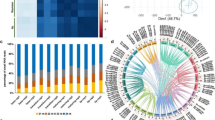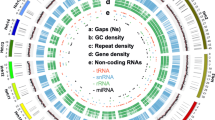Abstract
Quantitative real-time reverse transcription polymerase chain reaction (qRT-PCR) is a sensitive technique for analysis of gene expression under a wide diversity of biological conditions. However, the identification of suitable reference genes is a critical factor for analysis of gene expression data. To determine potential reference genes for normalization of qRT-PCR data in the green alga Volvox carteri, the transcript levels of ten candidate reference genes were measured by qRT-PCR in three experimental sample pools containing different developmental stages, cell types and stress treatments. The expression stability of the candidate reference genes was then calculated using the algorithms geNorm, NormFinder and BestKeeper. The genes for 18S ribosomal RNA (18S) and eukaryotic translation elongation factor 1α2 (eef1) turned out to have the most stable expression levels among the samples both from different developmental stages and different stress treatments. The genes for the ribosomal protein L23 (rpl23) and the TATA-box binding protein (tbpA) showed equivalent transcript levels in the comparison of different cell types, and therefore, can be used as reference genes for cell-type specific gene expression analysis. Our results indicate that more than one reference gene is required for accurate normalization of qRT-PCRs in V. carteri. The reference genes in our study show a much better performance than the housekeeping genes used as a reference in previous studies.




Similar content being viewed by others

References
Ginzinger DG (2002) Gene quantification using real-time quantitative PCR: an emerging technology hits the mainstream. Exp Hematol 30:503–512
Bustin SA, Benes V, Nolan T, Pfaffl MW (2005) Quantitative real-time RT-PCR–a perspective. J Mol Endocrinol 34:597–601
Huggett J, Dheda K, Bustin S, Zumla A (2005) Real-time RT-PCR normalisation; strategies and considerations. Genes Immun 6:279–284
Fleige S, Pfaffl MW (2006) RNA integrity and the effect on the real-time qRT-PCR performance. Mol Aspects Med 27:126–139
Guenin S, Mauriat M, Pelloux J, Van Wuytswinkel O, Bellini C, Gutierrez L (2009) Normalization of qRT-PCR data: the necessity of adopting a systematic, experimental conditions-specific, validation of references. J Exp Bot 60:487–493
Rocha-Martins M, Njaine B, Silveira MS (2012) Avoiding pitfalls of internal controls: validation of reference genes for analysis by qRT-PCR and Western blot throughout rat retinal development. PLoS ONE 7:e43028
Vandesompele J, De Preter K, Pattyn F, Poppe B, Van Roy N, De Paepe A, Speleman F (2002) Accurate normalization of real-time quantitative RT-PCR data by geometric averaging of multiple internal control genes, Genome Biol 3 RESEARCH0034
Thellin O, Zorzi W, Lakaye B, De Borman B, Coumans B, Hennen G, Grisar T, Igout A, Heinen E (1999) Housekeeping genes as internal standards: use and limits. J Biotechnol 75:291–295
Dheda K, Huggett JF, Chang JS, Kim LU, Bustin SA, Johnson MA, Rook GAW, Zumla A (2005) The implications of using an inappropriate reference gene for real-time reverse transcription PCR data normalization. Anal Biochem 344:141–143
Andersen CL, Jensen JL, Ørntoft TF (2004) Normalization of real-time quantitative reverse transcription-PCR data: a model-based variance estimation approach to identify genes suited for normalization, applied to bladder and colon cancer data sets. Cancer Res 64:5245–5250
Pfaffl MW, Tichopad A, Prgomet C, Neuvians TP (2004) Determination of stable housekeeping genes, differentially regulated target genes and sample integrity: BestKeeper - Excel-based tool using pair-wise correlations. Biotechnol Lett 26:509–515
Yin R, Liu X, Liu C, Ding Z, Zhang X, Tian F, Liu W, Yu J, Li L, Hrabe de Angelis M, Stoeger T (2011) Systematic selection of housekeeping genes for gene expression normalization in chicken embryo fibroblasts infected with Newcastle disease virus. Biochem Biophys Res Commun 413:537–540
Xu Y, Zhu X, Gong Y, Xu L, Wang Y, Liu L (2012) Evaluation of reference genes for gene expression studies in radish (Raphanus sativus L.) using quantitative real-time PCR. Biochem Biophys Res Commun 424:398–403
Cao S, Zhang X, Ye N, Fan X, Mou S, Xu D, Liang C, Wang Y, Wang W (2012) Evaluation of putative internal reference genes for gene expression normalization in Nannochloropsis sp. by quantitative real-time RT-PCR. Biochem Biophys Res Commun 424:118–123
Liu C, Wu G, Huang X, Liu S, Cong B (2012) Validation of housekeeping genes for gene expression studies in an ice alga Chlamydomonas during freezing acclimation. Extremophiles 16:419–425
Dong M, Zhang X, Chi X, Mou S, Xu J, Xu D, Wang W, Ye N (2012) The validity of a reference gene is highly dependent on the experimental conditions in green alga Ulva linza. Curr Genet 58:13–20
Siaut M, Heijde M, Mangogna M, Montsant A, Coesel S, Allen A, Manfredonia A, Falciatore A, Bowler C (2007) Molecular toolbox for studying diatom biology in Phaeodactylum tricornutum. Gene 406:23–35
Kang LK, Tsui FH, Chang J (2012) Quantification of diatom gene expression in the sea by selecting uniformly transcribed mRNA as the basis for normalization. Appl Environ Microbiol 78:6051–6058
Rosic NN, Pernice M, Rodriguez-Lanetty M, Hoegh-Guldberg O (2011) Validation of housekeeping genes for gene expression studies in Symbiodinium exposed to thermal and light stress. Mar Biotechnol (NY) 13:355–365
Le Bail A, Dittami SM, de Franco PO, Rousvoal S, Cock MJ, Tonon T, Charrier B (2008) Normalisation genes for expression analyses in the brown alga model Ectocarpus siliculosus. BMC Mol Biol 9:75
Kirk DL (1998) Volvox: molecular-genetic origins of multicellularity and cellular differentiation. Cambridge University Press, Cambridge
Hallmann A (2003) Extracellular matrix and sex-inducing pheromone in Volvox. Int Rev Cytol 227:131–182
Nematollahi G, Kianianmomeni A, Hallmann A (2006) Quantitative analysis of cell-type specific gene expression in the green alga Volvox carteri. BMC Genomics 7:321
Kirk MM, Stark K, Miller SM, Müller W, Taillon BE, Gruber H, Schmitt R, Kirk DL (1999) regA, a Volvox gene that plays a central role in germ-soma differentiation, encodes a novel regulatory protein. Development 126:639–647
Miller SM, Kirk DL (1999) glsA, a Volvox gene required for asymmetric division and germ cell specification, encodes a chaperone-like protein. Development 126:649–658
Hallmann A, Amon P, Godl K, Heitzer M, Sumper M (2001) Transcriptional activation by the sexual pheromone and wounding: a new gene family from Volvox encoding modular proteins with (hydroxy) proline-rich and metalloproteinase homology domains. Plant J 26:583–593
Ender F, Hallmann A, Amon P, Sumper M (1999) Response to the sexual pheromone and wounding in the green alga Volvox: induction of an extracellular glycoprotein consisting almost exclusively of hydroxyproline. J Biol Chem 274:35023–35028
Amon P, Haas E, Sumper M (1998) The sex-inducing pheromone and wounding trigger the same set of genes in the multicellular green alga Volvox. Plant Cell 10:781–789
Ueki N, Nishii I (2009) Controlled enlargement of the glycoprotein vesicle surrounding a Volvox embryo requires the InvB nucleotide-sugar transporter and is required for normal morphogenesis. Plant Cell 21:1166–1181
Nishii I, Ogihara S, Kirk DL (2003) A kinesin, invA, plays an essential role in Volvox morphogenesis. Cell 113:743–753
Ertl H, Hallmann A, Wenzl S, Sumper M (1992) A novel extensin that may organize extracellular matrix biogenesis in Volvox carteri. EMBO J 11:2055–2062
Hallmann A, Kirk DL (2000) The developmentally regulated ECM glycoprotein ISG plays an essential role in organizing the ECM and orienting the cells of Volvox. J Cell Sci 113:4605–4617
Fukada K, Inoue T, Shiraishi H (2006) A posttranslationally regulated protease, VheA, is involved in the liberation of juveniles from parental spheroids in Volvox carteri. Plant Cell 18:2554–2566
Hallmann A, Sumper M (1994) An inducible arylsulfatase of Volvox carteri with properties suitable for a reporter-gene system. Purification, characterization and molecular cloning. Eur J Biochem 221:143–150
Kianianmomeni A, Nematollahi G, Hallmann A (2008) A gender-specific retinoblastoma-related protein in Volvox carteri implies a role for the retinoblastoma protein family in sexual development. Plant Cell 20:2399–2419
Adams CR, Stamer KA, Miller JK, McNally JG, Kirk MM, Kirk DL (1990) Patterns of organellar and nuclear inheritance among progeny of two geographically isolated strains of Volvox carteri. Curr Genet 18:141–153
Starr RC (1969) Structure, reproduction and differentiation in Volvox carteri f. nagariensis Iyengar, strains HK 9 & 10. Arch Protistenkd 111:204–222
Provasoli L, Pintner IJ (1959) Artificial media for fresh-water algae: problems and suggestions. In: Tryon CA, Hartman RT (Eds.) The Ecology of Algae, a symposium held at the Pymatuning Laboratory of Field Biology on June 18 and 19, 1959, (ed.), Pittsburgh, PA: The Pymatuning Symposia in Ecology, Special Publication No. 2., University of Pittsburgh, pp 84–96
Starr RC, Jaenicke L (1974) Purification and characterization of the hormone initiating sexual morphogenesis in Volvox carteri f. nagariensis Iyengar. Proc Natl Acad Sci USA 71:1050–1054
Kirk DL, Kirk MM (1986) Heat shock elicits production of sexual inducer in Volvox. Science 231:51–54
Kianianmomeni A, Stehfest K, Nematollahi G, Hegemann P, Hallmann A (2009) Channelrhodopsins of Volvox carteri are photochromic proteins that are specifically expressed in somatic cells under control of light, temperature, and the sex inducer. Plant Physiol 151:347–366
Langnaese K, John R, Schweizer H, Ebmeyer U, Keilhoff G (2008) Selection of reference genes for quantitative real-time PCR in a rat asphyxial cardiac arrest model. BMC Mol Biol 9:53
Prochnik SE, Umen J, Nedelcu AM, Hallmann A, Miller SM, Nishii I, Ferris P, Kuo A, Mitros T, Fritz-Laylin LK, Hellsten U, Chapman J, Simakov O, Rensing SA, Terry A, Pangilinan J, Kapitonov V, Jurka J, Salamov A, Shapiro H, Schmutz J, Grimwood J, Lindquist E, Lucas S, Grigoriev IV, Schmitt R, Kirk D, Rokhsar DS (2010) Genomic analysis of organismal complexity in the multicellular green alga Volvox carteri. Science 329:223–226
Exposito-Rodriguez M, Borges AA, Borges-Perez A, Perez JA (2008) Selection of internal control genes for quantitative real-time RT-PCR studies during tomato development process. BMC Plant Biol 8:131
Chechi K, Gelinas Y, Mathieu P, Deshaies Y, Richard D (2012) Validation of reference genes for the relative quantification of gene expression in human epicardial adipose tissue. PLoS ONE 7:e32265
Livak KJ, Schmittgen TD (2001) Analysis of relative gene expression data using real-time quantitative PCR and the 2−∆∆C T method. Methods 25:402–408
Khanlou KM, Van Bockstaele E (2012) A critique of widely used normalization software tools and an alternative method to identify reliable reference genes in red clover (Trifolium pratense L.). Planta 236:1381–1393
Beekman L, Tohver T, Dardari R, Leguillette R (2011) Evaluation of suitable reference genes for gene expression studies in bronchoalveolar lavage cells from horses with inflammatory airway disease. BMC Mol Biol 12:5
Maroufi A, Van Bockstaele E, De Loose M (2010) Validation of reference genes for gene expression analysis in chicory (Cichorium intybus) using quantitative real-time PCR. BMC Mol Biol 11:15
Acknowledgments
The authors thank Kordula Puls for technical assistance.
Conflict of interests
The authors declare that they have no competing interests.
Author information
Authors and Affiliations
Corresponding author
Electronic supplementary material
Below is the link to the electronic supplementary material.
11033_2013_2784_MOESM1_ESM.docx
Supplemental Figure S1. RNA sampling and diversity of samples. Supplemental Figure S2. Separate analysis of each sample pool by geNorm – Average expression stability during stepwise exclusion of the least stable candidate reference gene. (DOCX 718 kb)
11033_2013_2784_MOESM3_ESM.docx
Supplemental Table S2. Detailed list of Ct values of the ten candidate reference genes at all investigated biological or experimental conditions. (DOCX 31 kb)
Rights and permissions
About this article
Cite this article
Kianianmomeni, A., Hallmann, A. Validation of reference genes for quantitative gene expression studies in Volvox carteri using real-time RT-PCR. Mol Biol Rep 40, 6691–6699 (2013). https://doi.org/10.1007/s11033-013-2784-z
Received:
Accepted:
Published:
Issue Date:
DOI: https://doi.org/10.1007/s11033-013-2784-z



